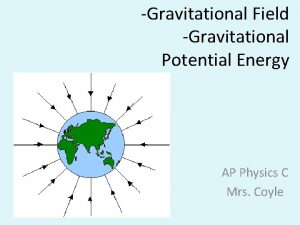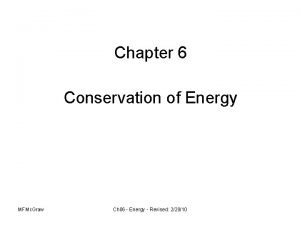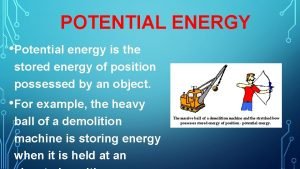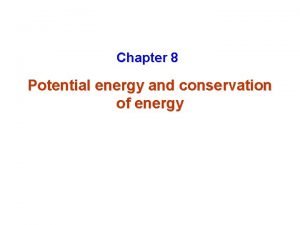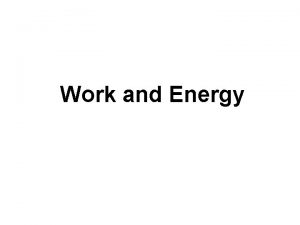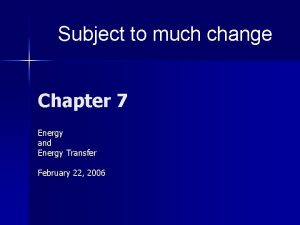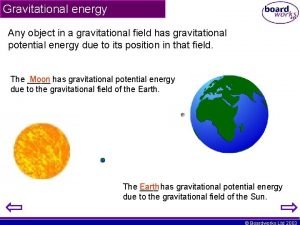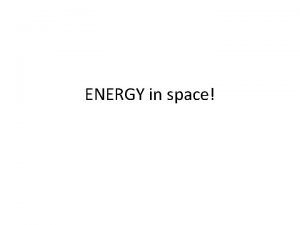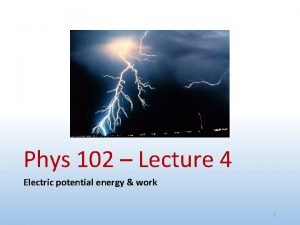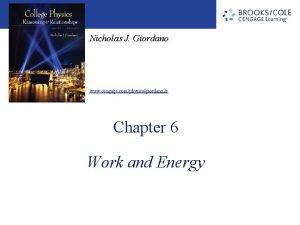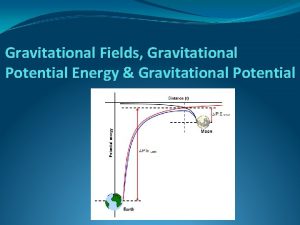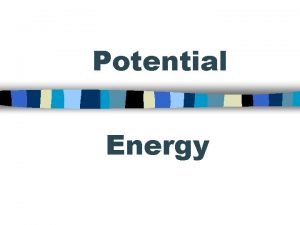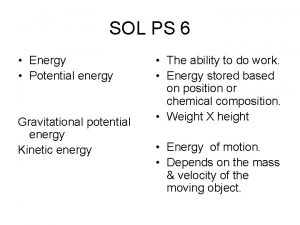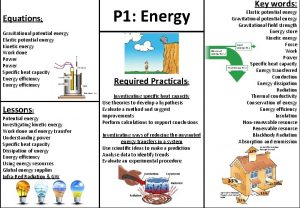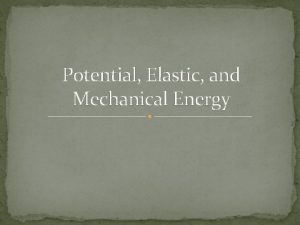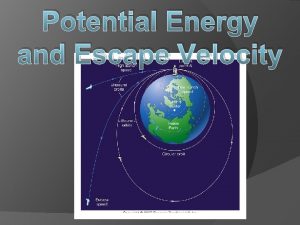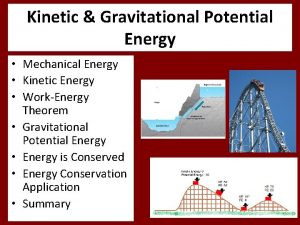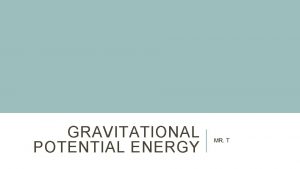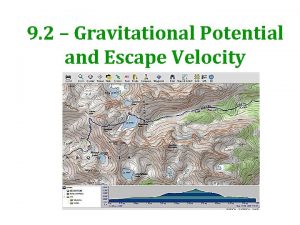We can find Gravitational Potential Energy m 1





























- Slides: 29




We can find Gravitational Potential Energy m 1 m 2 U (r ) = -G r

Consider now a different type of a force…. .

Richard P. Feynman 1918 -1988 Nobel Prize in Physics, 1965 From long view of the history of mankind – seen from, say, ten thousand years from now – there can be little doubt that the most significant event of the 19 th century will be judged as Maxwell’s discovery of the laws of electrodynamics. The American Civil War will pale into provincial insignificance in comparison with this important scientific event of the same decade.

Consider a force like gravitation which varies as but 1) billion-billion-billion times stronger; 2) there are two kinds of “matter”: positive and negative; Like kinds repel and unlike kinds attract (unlike gravity where there is only attraction) + + + _ _ _

Electrical force All matter is a mixture of positive protons and negative electrons which are attracting and repelling with this great force. How perfect is the balance? -when you stand near someone else you don’t feel any force at all; -if you were standing at arm’s length from someone and each of you had one percent more electrons than protons, the repelling force would be enough to lift a “weight” equal to that of the entire earth! The force that holds atom together, and the chemical forces that holds molecules together, are electrical forces!

Atoms are made with positive protons in the nucleus and with electrons outside This picture is obsolete!

If this electrical force is so terrific, why don’t the protons and electrons just get on top of each other? Laws of quantum mechanics rule it out… What holds the nucleus together? A Helium Atom -There also nuclear forces – fall off much more rapidly than

An important consequence…. . Consider uranium with 92 (!) protons. The balance between the nuclear forces and electrical repulsion is so delicate that the nucleus is almost ready to fly apart. If we “tapped” it slightly……


Matter is effected by forces or interactions (the terms are interchangeable) There are four fundamental forces in the Universe: gravitation (between particles with mass) electromagnetic (between particles with charge) strong nuclear force (between quarks) weak nuclear force (that changes quark types)



The atom contains a nucleus surrounded by a cloud of negatively charged electrons. The nucleus is composed of neutral neutrons and positively charged protons. The opposite charge of the electron and proton binds the atom together with electromagnetic forces.

Atom is mostly empty space! Magnify a hydrogen atom by Size of proton or neutron: ~10 -15 m Size of an electron cloud: ~10 -10 m (1 Angstrom) Proton mass: 1. 7 x 10 -27 kg Electron mass: 9 x 10 -31 kg the diameter of the electron cloud about 4. 5 times longer than a football field


What holds a negatively charged electron together ? (since it has no nuclear force) 1909: Robert Millikan famous oil drop experiment The smallest charge we ever observed is the “elementary charge”: By convention, the electron has negative sign, the proton positive.

Electrostatics • (the interactions of electric charges that are at rest in our frame of reference) • There are two kinds of charge, positive and negative. Charges of the same sign repel each other; charges of the opposite sign attract. • All ordinary matter is made of protons, neutrons, and electrons. The positive protons and electrically neutral neutrons in nucleus of an atom are bound together by the nuclear force.

Continue …. • The negative electrons surround the nucleus at distances much greater than the nuclear size. • Electric interactions are chiefly responsible for the structure of atoms, molecules, and solids.

Coulomb’s Law is the permittivity of free space Charge Conservation of electric charge Charge is conserved: in any isolated system, the total charge cannot change. If it does change, then the system is not isolated: charge either went somewhere or came in from somewhere

y L T q q x mg

If the length is 1 meter, q = 1 Coulomb, what is mg? y L T q q x mg Your weight? –

If we measure and know q and m, we can determine y L T q q x mg

Exercise: If two electrons are placed meters apart, what is the magnitude of the Coulomb force between them? Compare this to the gravitational force between them. Solution: The magnitude of electric force The magnitude of gravitational force (no matter what the separation is)

Principle of Superposition The presence of other charges does not change the force exerted by point charges. One can obtain the total force by adding or superimposing the forces exerted by each particle separately. Suppose we have a number N of charges scattered in some region. We want to calculate the force that all of these charges exert on some test charge.

Problem 2 page 9 Two equal, positive charges of magnitude are positioned along the x-axis as shown. What would be the force on a positive charge, , placed on the y-axis a distance H from the x-axis? y q 0 H q q a a x

Have a great day! Hw: All Chapter 1 problems and exercises Reading: Chapter 1, 2
 Gravitational kinetic energy
Gravitational kinetic energy Gravitational potential energy vs kinetic energy
Gravitational potential energy vs kinetic energy Gravitational potential energy formula
Gravitational potential energy formula Gravitional energy
Gravitional energy Gravitational potential energy
Gravitational potential energy Expression for gravitational potential energy
Expression for gravitational potential energy Gravitational potential energy
Gravitational potential energy Examples of electrical energy
Examples of electrical energy Gpe mgh
Gpe mgh Potential energy
Potential energy Elastic potential energy formula
Elastic potential energy formula At y a
At y a Gravitational potential energy
Gravitational potential energy Gravitational potential energy
Gravitational potential energy Efficiency equation
Efficiency equation Power formula
Power formula Electric potential energy and potential difference
Electric potential energy and potential difference Potential energy of capacitor
Potential energy of capacitor V=pe/q
V=pe/q Electric potential isolines
Electric potential isolines Kinetic energy from force
Kinetic energy from force How to find electric potential energy
How to find electric potential energy Can potential energy be negative
Can potential energy be negative Can potential energy be negative
Can potential energy be negative Potential energy to chemical energy examples
Potential energy to chemical energy examples Mechanical energy example
Mechanical energy example What is kinetic and potential energy
What is kinetic and potential energy Kinetic energy
Kinetic energy Spring potential and kinetic energy
Spring potential and kinetic energy Conservation of mechanical energy
Conservation of mechanical energy




